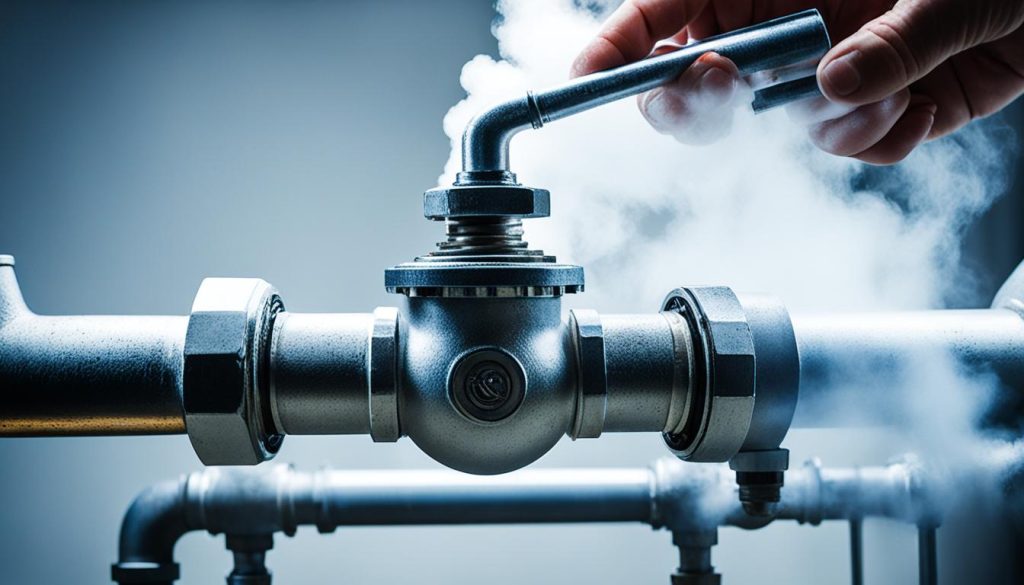Clearing My Plumbing Vent: A Step-by-Step Guide
Did you know that clogged plumbing vents can lead to the buildup of hazardous sewer gases in your home? It’s true! Just like drain pipes, plumbing vents can also become blocked, causing a range of plumbing issues and potential health risks. That’s why it’s crucial to know how to clean a plumbing vent effectively.
In this comprehensive guide, I will take you through the step-by-step process of cleaning out your plumbing vent. From understanding the importance of regular vent cleaning to learning about the tools and supplies you’ll need, we’ll cover it all. You’ll discover easy ways to maintain a clean plumbing vent and prevent any future plumbing problems.
Key Takeaways:
- Regularly cleaning your plumbing vent can prevent sewer gas buildup and maintain a healthy home environment.
- Gather essential tools such as a flashlight, garden hose, gloves, and a plumbing auger before starting the cleaning process.
- The step-by-step guide will help you effectively clean your plumbing vent and ensure its proper functioning.
- Alternative methods exist for unclogging plumbing vents without accessing the roof.
- Preventive measures such as installing screens and regular maintenance can help maintain a clean plumbing vent.
The Importance of Cleaning Plumbing Vents
Cleaning plumbing vents is essential for the proper functioning of your home’s plumbing system. Regular maintenance and cleaning of these vents offer numerous benefits, ensure the safety of your family, and prevent plumbing issues.
Benefits of Cleaning Plumbing Vents
- Prevents sewer gas buildup: Plumbing vents are designed to release sewer gases safely out of your home. Clogged plumbing vents can lead to the accumulation of these toxic gases within your living space, posing serious health risks.
- Eliminates unpleasant odors: Foul odors emanating from sinks, drains, or toilets can be a sign of a clogged plumbing vent. Regularly cleaning your vents helps eliminate these odors, creating a more pleasant and hygienic environment in your home.
- Promotes proper drainage: Clogged plumbing vents can cause slow drainage and gurgling noises in your fixtures. By keeping your vents clean and clear, you can ensure a smooth flow of water, preventing backups and clogs in your pipes.
- Prevents moisture damage: Clogged plumbing vents can lead to excess moisture accumulation, which can cause damage to your walls, ceilings, and other structural components of your home. Regular cleaning helps prevent mold growth, water leaks, and other moisture-related issues.
Health Risks of Clogged Plumbing Vents
Clogged plumbing vents pose significant health risks to you and your family. When the vent is obstructed, sewer gases containing harmful substances, such as methane and hydrogen sulfide, can build up in your home. These gases can cause various health problems, including respiratory issues, nausea, headaches, and even fainting. It is crucial to clean your plumbing vents regularly to safeguard the well-being of your household.
Preventing Plumbing Issues with Vent Cleaning
Maintaining a clean plumbing vent is a proactive way to prevent plumbing issues from occurring. By including vent cleaning as part of your regular home maintenance routine, you can prevent clogs, backups, and other costly plumbing problems. Regular cleaning also extends the lifespan of your plumbing system, saving you money on repairs and replacements in the long run.
Remember, when it comes to cleaning your plumbing vents, it’s best to rely on professional plumbers for thorough and effective results. They have the knowledge, experience, and specialized tools to ensure a proper cleaning without causing any damage to the pipes or other components of your plumbing system.
| Benefits of Cleaning Plumbing Vents |
|---|
| Prevents sewer gas buildup |
| Eliminates unpleasant odors |
| Promotes proper drainage |
| Prevents moisture damage |
Tools and Supplies for Cleaning Plumbing Vents
Before embarking on the task of cleaning your plumbing vent, it’s important to gather all the necessary tools and supplies. Having the right equipment will ensure that you can effectively clean and clear any obstructions in your plumbing vent, promoting the smooth operation of your entire plumbing system.
| Tools | Supplies |
|---|---|
| Flashlight | – |
| Garden hose | – |
| Gloves | – |
| Hacksaw | – |
| Ladder | – |
| Mask | – |
| Plumbing auger or snake | – |
| Rope | – |
| Screwdriver | – |
These essential tools and supplies are readily available and will greatly assist you in your plumbing vent cleaning endeavor. Let’s take a closer look at the purpose of each item:
- Flashlight: A flashlight will help you effectively navigate and inspect the interior of the plumbing vent.
- Garden hose: A garden hose with a powerful nozzle will be used to flush out any remaining debris from the vent pipe.
- Gloves: Gloves will protect your hands from dirt, debris, and potential hazards while cleaning the plumbing vent.
- Hacksaw: A hacksaw may be necessary to remove any sections of the vent pipe that are damaged or obstructed.
- Ladder: A sturdy ladder will provide you with safe access to the roof where the plumbing vent is located.
- Mask: Wearing a mask is essential to protect yourself from inhaling harmful particles and odors during the cleaning process.
- Plumbing auger or snake: A plumbing auger or snake is a flexible tool that can be used to dislodge and remove any stubborn obstructions within the plumbing vent.
- Rope: A rope can be used to secure yourself and the necessary equipment while working on the roof.
- Screwdriver: A screwdriver may come in handy for loosening or removing screws or fasteners during the cleaning process.
Having these tools and supplies readily available will ensure that you are well-equipped to tackle any clogs or blockages in your plumbing vent. With the right equipment, you’ll be able to maintain a clean and functional plumbing system, promoting the overall efficiency and longevity of your home’s plumbing system.
Step-by-Step Guide to Cleaning a Plumbing Vent
If you want to ensure the smooth operation of your home’s plumbing system, it’s important to regularly clean your plumbing vent. Cleaning a plumbing vent is a relatively simple process that can prevent plumbing issues and maintain the proper functioning of your plumbing system. Here is a step-by-step guide to help you clean your plumbing vent effectively:
- Step 1: Access the roof safely using a ladder with non-slip feet.
- Step 2: Remove any visible debris, such as leaves and branches, from the vent pipe. This can be done by hand or using a brush or broom.
- Step 3: Put on gloves and a mask to protect yourself from any potential hazards.
- Step 4: Reach down the vent pipe and remove any remaining obstructions, such as bird nests or debris. You can use a plumbing auger or snake to help dislodge stubborn blockages.
- Step 5: Once you have removed the visible obstructions, use a garden hose with a powerful nozzle to spray water down the vent pipe. This will help push out any remaining debris and ensure the vent is clear.
- Step 6: Finally, to confirm if the plumbing vent is working properly, have someone flush the toilet inside the house while you feel for suction at the vent opening on the roof.
By following these step-by-step instructions, you can effectively clean your plumbing vent and maintain a properly functioning plumbing system in your home.
Alternative Methods for Unclogging Plumbing Vents
In some situations, you may encounter a clogged plumbing vent and need to find alternative methods to unclog it without having to climb onto the roof. Here are two effective alternatives to consider:
1. Accessing the Vent Pipe from the Attic
If you have attic access, this method allows you to reach the plumbing vent without the need for roof access. Here’s how you can do it:
- Put on protective gear, including gloves and a mask.
- Locate the vent pipe in your attic.
- Using a plumbing auger or snake, carefully insert it into the vent pipe.
- Rotate the auger or snake while applying gentle pressure to break up and remove the blockage.
- Once you’ve cleared the blockage, flush water down the vent pipe to ensure it’s completely clear.
2. Melting Snow and Ice from the Inside
In colder climates, snow and ice can accumulate on the plumbing vent, causing a blockage. To clear the blockage from inside, follow these steps:
- Run hot water down the drains connected to the plumbing vent. The heat will help melt the snow and ice obstructing the vent.
- If the clog persists, use a hairdryer or heat tape near the vent pipe to apply heat directly and melt the blockage.
- Monitor the vent to ensure that the snow and ice have melted and the blockage has cleared.
These alternative methods provide effective solutions for unclogging your plumbing vent without the need to climb onto the roof. Choose the method that is most suitable for your situation and ensure that the vent is clear to maintain the proper functioning of your plumbing system.
Preventive Measures for Maintaining a Clean Plumbing Vent
As a responsible homeowner, it’s important to take preventive measures to maintain a clean and clog-free plumbing vent. This not only helps prevent potential plumbing issues but also ensures the proper functioning of your entire plumbing system. Here are some effective tips for preventing clogged plumbing vents and maintaining regular maintenance:
1. Install a screen or filter over the vent: One of the simplest ways to prevent debris from falling into your plumbing vent is by installing a screen or filter over it. This barrier will catch leaves, twigs, and other debris before they have a chance to enter the vent and cause a clog.
2. Regularly clean your roof: Leaves, branches, and other debris can accumulate on your roof over time, posing a risk of clogging your plumbing vent. Make it a habit to regularly clean your roof, especially during the fall when leaves tend to be abundant. By removing this debris, you can minimize the chances of clogs and maintain proper ventilation.
3. Consider replacing old plumbing vents: If you have older plumbing vents that are more prone to clogs, it may be worth considering an upgrade. Newer models often come with caps or guards that provide an extra layer of protection against debris, reducing the risk of clogging. Consult a professional plumber to determine if replacing your plumbing vent is a viable option.
By implementing these preventive measures and regularly maintaining your plumbing vent, you can save yourself from the hassle of dealing with clogs and potential plumbing problems down the line. Remember, a clean and functioning plumbing vent is crucial for the overall health and efficiency of your home’s plumbing system.
Source Links
- https://jblantonplumbing.com/how-to-clean-a-plumbing-vent/
- https://www.angi.com/articles/vent-stacks-air-out-your-plumbing.htm
- https://wpplumbing.com.au/blog/how-to-clean-plumbing-vents
- Investing Wisely: How Windows & Doors in Boost Property Value and Financial Health - April 24, 2025
- The Financial Impact of Personal Injuries: Why Legal Help Matters for Business Owners - April 16, 2025
- The Hidden Financial Costs of Domestic Assault: What Business Owners Need to Know - April 16, 2025













